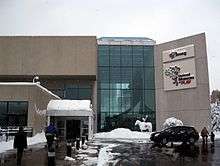The Strong National Museum of Play

The National Museum of Play, formerly Strong National Museum of Play, is part of The Strong in Rochester, New York, United States. Established in 1969 and based initially on the personal collection of Rochester, NY native Margaret Woodbury Strong, the museum opened to the public in 1982. Since then it has refined and increased its collections (hundreds of thousands of items), and expanded twice, in 1997 and 2006.[1][2] The museum is now one of five Play Partners of The Strong, which is also home to the National Toy Hall of Fame, the International Center for the History of Electronic Games, and the Brian Sutton-Smith Library and Archives of Play, and produces the American Journal of Play.
Overview

Known originally as the Margaret Woodbury Strong Museum and later simply as the Strong Museum, it became the Strong National Museum of Play in 2006, after completing renovations and an expansion that nearly doubled its size to 282,000 square feet (26,200 m2).[3] The National Museum of Play is the only collections-based museum anywhere devoted solely to the study of play, and although it is a history museum, it has the interactive characteristics of a children’s museum making it the second largest museum of that type in the United States.[4][5][6][7] The museum includes exhibits that interpret the key elements of play, as well as allow guests to explore the worlds of Sesame Street, the Berenstain Bears, Reading Adventureland, and the Dancing Wings Butterfly Garden.[8][9][10][11]
The museum's exhibits are immersively themed for video games, storybooks, television shows, education, nature, history, comic books, carousel and train rides, and children's lifestyles. eGameRevolution is the first permanent video game exhibit in the US and includes the World Video Game Hall of Fame. The National Toy Hall of Fame is at the museum. Dancing Wings Butterfly Garden features thousands of butterflies, and is the largest indoor butterfly garden in New York. The Berenstain Bears: Down a Sunny Dirt Road is an original, permanent exhibit produced in partnership with the Berenstain family.
See also
References
- ↑ Adams, Rollie G. “Ready, Set, Go: Finally a Museum of Play.” History News 61, no. 3. (2006): 7-11
- ↑ Bensch, Christopher. “From Decorative Arts to the World of Play—Strong Museum Evolves.” Newsletter of the Decorative Arts Society, Inc. 15, no. 3. (2007)
- ↑ Tangorra Matelic, Candace. “Understanding Change and Transformations in History Organizations.” History News 63, no. 2 (2008): 7-13
- ↑ Alexander, Edward P. and Mary, Museums in Motion: An Introduction to the History and Functions of Museums, 2nd ed. Lanham: AltaMira Press, 2008.
- ↑ Kotler, Neil G. Museum Marketing and Strategy: Designing Missions, Building Audiences, Generating Revenue and Resources. San Francisco, CA: Jossey-Bass, 2008.
- ↑ Brown, Stuart. Play: How it Shapes the Brain, Opens the Imagination, and Invigorates the Soul. New York: Penguin Group, 2009.
- ↑ Hoffman, Joan and Sara Boettrich. “Setting the Stage for Free Play: Museum Environments That Inspire Creativity.” Hand-to-Hand 22, no. 4. (2008): 3-5
- ↑ Eberle, Scott. G. “How a Museum Discovered the Transforming Power of Play.” Journal of Museum Education 33, no. 3 (2008): 265-272
- ↑ Bitter, Ann. “Challenging Transitions: Planning for Change.” Hand-to-Hand 17, no. 2 (2003): 2-8
- ↑ Skramstad, Harold and Susan. A Handbook for Museum Trustees. Washington, D.C.: American Association of Museums, 2003.
- ↑ Weil, Stephen E. Making Museums Matter. Washington, D.C.: Smithsonian Institution Press, 2002.
External links
- The National Museum of Play official website
- American Journal of Play official website
- Rochester Wiki Article and photos
- The Strong National Museum of Play at Google Cultural Institute
Coordinates: 43°09′09″N 77°36′06″W / 43.1526°N 77.601543°W